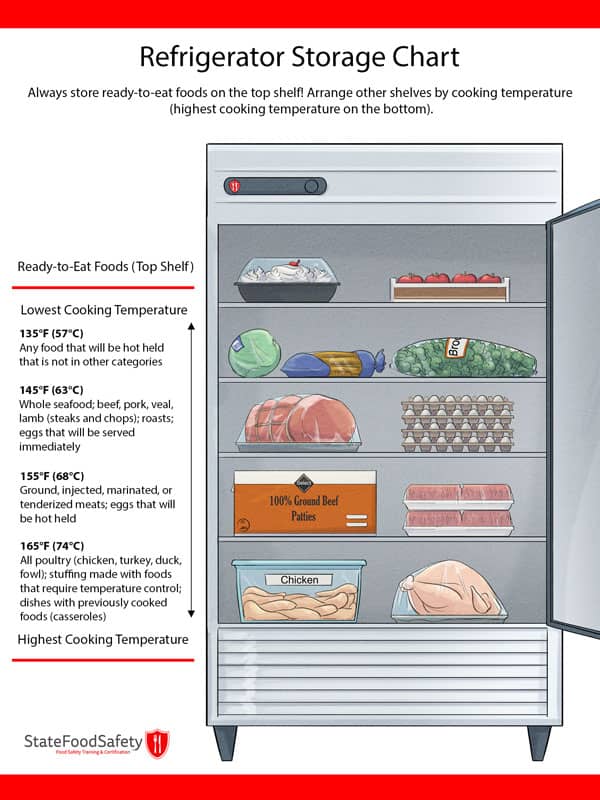Whole Cut of Beef Pork Lamb and Veal Temp
Although it may seem like a small part of food preparation, refrigeration plays a large role in keeping food safe. The temperature of the refrigerator, the order of the food on shelves, and the amount of time left in the refrigerator can all play a large role in the growth of bacteria or other harmful pathogens on the food.

Follow these three food storage rules to keep you and your customers safe.
1. Know the recommended refrigerator temperature
To avoid your food reaching a temperature where pathogens can grow on your food, it's important to measure the temperature of your refrigerator often. Keeping your refrigerator at 41°F (5°C) or below ensures an environment that will minimize the growth of pathogens.
Many refrigerators come with built in thermometers; if your fridge does not have this feature, an appliance thermometer should be kept in the fridge.
This can be very important, especially if there is a power outage. If when the power comes on, the refrigerator is still at 41°F or lower, the food is safe to consume. If the temperature of the refrigerator goes above 41°F, food should not be consumed as there is an increased risk of foodborne illness.
2. Arrange by proper food storage order
Although it may not seem like it would matter, the wrong order of food on shelves could potentially promote the growth of pathogens, increasing the risk of foodborne illness. Shelves should be ordered from lowest cooking temperature to highest, going down. This is done to prevent juices or other liquids from higher temperature cooking foods from contaminating foods that won't reach that temperature.
Let's break down what foods should be kept on each shelf.
Top Shelf: Ready-to-Eat
The top shelf should be reserved for ready-to-eat foods. These are foods that will be served without being cooked first.
Second Shelf: 135°F (57°C)
This category includes foods that will be hot-held that are not included in other categories.
Third Shelf: 145°F (63°C)
Foods that should be cooked to 145°F include whole seafood; whole cuts of beef, pork, veal, lamb; roasts; and eggs that will be served immediately.
Fourth Shelf: 155°F (68°C)
It is important that meat that has been ground, injected, or tenderized be kept on a lower shelf. This category also includes eggs that will be hot held.
Bottom Shelf: 165°F (74°C)
The bottom shelf should hold foods with the highest cooking temperatures. This includes all poultry (turkey, duck, chicken, or fowl); stuffing that contains foods that require temperature control; dishes with previously cooked foods, such as casseroles.
3. Know when to throw food away
Although refrigerators slow the growth of pathogens, it should be remembered that they do not stop the spoiling process. Throwing food away can seem like a waste, but knowing when to throw out food can help keep you and your customers safe and healthy.
Leftovers can often be kept for a few days, but should be thrown out before they spoil. Food that has been left out of the fridge for over 2 hours should not be consumed, even if it was put back in the fridge. When in doubt, throw it out.
Follow this food storage chart to know how long food can be kept:
Up to 2 Days
Ground beef, turkey, veal, pork, lamb; stew meats; variety meats; whole chicken or turkey; giblets; raw or poultry sausage; fresh fish and shellfish.
Up to 4 days
Cooked egg dishes; soups and stews; cooked casseroles; gravy, broth, patties, and nuggets; store-cooked dinners and entrees; fully-cooked ham slices.
Up to 5 days
Canned ham (labeled "Keep Refrigerated"); egg, chicken, tuna, ham, and macaroni salads; opened luncheon meats; fully-cooked ham, half.
Up to 7 days
Bacon; smoked sausage links or patties; fully-cooked ham, whole; corned beef in pouch (with pickling juices)
Up to 2 weeks
Unopened hot dog and luncheon meat packages.
Up to 3 weeks
Opened summer sausage packages; hard sausage (such as pepperoni)
This chart is meant to be a guide. If something exhibits qualities associated with spoiling, such as an unpleasant smell, discoloration, or an off-flavor, it should be disposed.
Leftovers should be kept as long as the fastest-spoiling ingredient it contains. For example, a casserole containing bacon should only be kept for a maximum of 4 days because it is a casserole, regardless of the fact that the bacon would be good for another 3 days.
Being aware of the ingredients of your dish and how long they are good for can help reduce the occurrence of foodborne illness.
Following these simple rules when it comes to refrigeration can help ensure food is safe to consume. Checking the temperature of the refrigerator, ensuring you order your food from lowest to highest cooking temperature, and storing food for the appropriate amount of time can help keep your food safe and your customers happy.
For more information and other food safety tips, take our online Food Handler course .
Share our poster with others!
- Download and print: Click on the image above to download and print out the poster.
- Share the link: Share https://www.statefoodsafety.com/Resources/Posters/fridge-storage-for-food-safety on your website or social media.
- Embed the poster on your site by copying this code: <a href="https://www.statefoodsafety.com/Resources/Posters/fridge-storage-for-food-safety"><img src="https://cdn.statefoodsafety.com/blog/2018/08/Fridge-Poster_With-Text.psd.jpg" width="100%" border="0″ /></a>
Source: https://www.statefoodsafety.com/Resources/Resources/fridge-storage-for-food-safety
0 Response to "Whole Cut of Beef Pork Lamb and Veal Temp"
Post a Comment